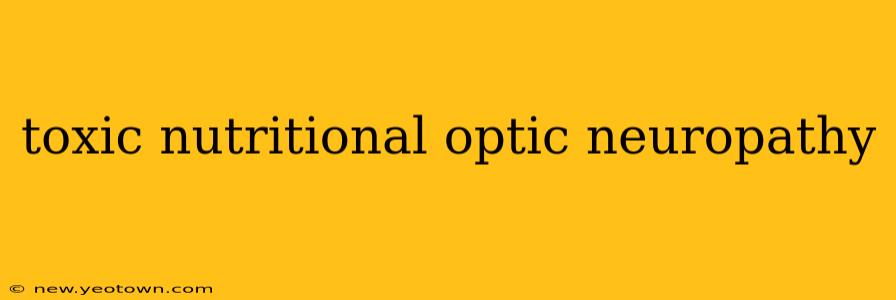Toxic nutritional optic neuropathy is a devastating condition affecting the optic nerve, leading to vision loss and even blindness. It's not a single disease but rather a group of conditions stemming from nutritional deficiencies or toxic exposures. Understanding the intricacies of this complex issue is crucial for both prevention and effective treatment. Let's embark on a journey to uncover its secrets.
Imagine a bustling city, the optic nerve, its intricate network of pathways carrying visual information to the brain. Now, picture this city under siege – ravaged by malnutrition and poisoned by toxins. This is essentially what happens in toxic nutritional optic neuropathy. The delicate balance within the optic nerve is disrupted, leading to irreversible damage if left unaddressed.
What are the common causes of toxic nutritional optic neuropathy?
This condition isn't a simple case of one cause; instead, it's a complex interplay of factors. The most frequent culprits are nutritional deficiencies and toxic exposures.
Nutritional Deficiencies: The optic nerve, like any other part of the body, requires specific nutrients to thrive. A severe deficiency in key vitamins and minerals can lead to degeneration. This is especially true for:
- Vitamin B12: Crucial for nerve function, a severe deficiency can directly damage the optic nerve.
- Vitamin B1: Plays a vital role in energy production within the nerve cells. Its absence can lead to significant impairment.
- Folate (Vitamin B9): Essential for cell growth and development, folate deficiency can disrupt the optic nerve's health.
Toxic Exposures: Certain toxins can inflict direct damage on the optic nerve. These can include:
- Methanol: Found in some industrial solvents and improperly processed alcoholic beverages, methanol is particularly toxic to the optic nerve.
- Heavy Metals: Exposure to lead, arsenic, or mercury can lead to optic nerve damage, often accompanied by other systemic effects.
- Certain Drugs: Some medications, especially those used for chemotherapy, can have toxic effects on the optic nerve as a side effect.
What are the symptoms of toxic nutritional optic neuropathy?
The symptoms often creep in gradually, making early detection challenging. Initially, you may experience subtle changes in your vision, such as:
- Blurred vision: This is a common initial symptom, often noticed gradually.
- Color vision changes: Difficulty distinguishing certain colors or a muted appearance of colors.
- Central vision loss: This is a hallmark of the disease, often affecting the ability to see clearly in the center of the visual field.
- Loss of visual acuity: The sharpness of your vision diminishes progressively.
As the condition progresses, the vision loss can become more severe, potentially leading to:
- Peripheral vision loss: A reduction in the ability to see at the edges of your visual field.
- Complete blindness: In severe cases, complete loss of vision is a possible outcome.
It's critical to seek medical attention immediately if you experience any of these symptoms.
How is toxic nutritional optic neuropathy diagnosed?
Diagnosis involves a thorough examination by an ophthalmologist or neuro-ophthalmologist. Tests typically include:
- Visual acuity tests: Measuring the sharpness of your vision.
- Visual field tests: Assessing the extent of your visual field.
- Fundoscopy (ophthalmoscopy): Examining the optic nerve and retina using an ophthalmoscope.
- Optical coherence tomography (OCT): Using light waves to create detailed images of the optic nerve.
- Blood tests: To assess for vitamin deficiencies and the presence of toxins.
What are the treatment options for toxic nutritional optic neuropathy?
Treatment depends on the underlying cause and the severity of the damage. Options can include:
- Nutritional supplementation: Addressing vitamin deficiencies with appropriate supplements. This is particularly crucial for B12, B1, and folate deficiencies.
- Chelation therapy: Removing heavy metals from the body through chelation therapy, if heavy metal toxicity is identified.
- Management of toxic exposures: Identifying and eliminating the source of toxic exposure, where applicable.
- Supportive care: Measures to manage symptoms and improve quality of life, such as low vision aids and rehabilitation.
Early intervention is vital for maximizing the chances of successful treatment and preventing irreversible vision loss.
Can toxic nutritional optic neuropathy be prevented?
Prevention is key. Maintaining a balanced diet rich in essential vitamins and minerals is fundamental. Avoiding exposure to toxins, such as methanol and heavy metals, is also crucial. Regular eye exams can aid in early detection, allowing for prompt treatment before irreversible damage occurs.
This journey into the world of toxic nutritional optic neuropathy highlights the importance of maintaining a healthy lifestyle and seeking prompt medical care if any vision changes are detected. Remember, your vision is precious, and its preservation is paramount.

